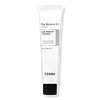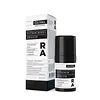What's inside
What's inside
 Key Ingredients
Key Ingredients

 Benefits
Benefits

 Concerns
Concerns

 Ingredients Side-by-side
Ingredients Side-by-side

Water
Skin ConditioningCaprylic/Capric Triglyceride
MaskingPropanediol
SolventGlycerin
HumectantTocopheryl Acetate
AntioxidantCetearyl Alcohol
EmollientButyrospermum Parkii Butter
Skin ConditioningPanthenol
Skin ConditioningTrehalose
HumectantGlycine Soja Oil
EmollientAmmonium Acryloyldimethyltaurate/Vp Copolymer
Dimethicone
EmollientGlyceryl Polymethacrylate
Helianthus Annuus Seed Oil
EmollientPolyglyceryl-10 Stearate
Skin ConditioningHydrogenated Lecithin
EmulsifyingHydroxyethyl Acrylate/Sodium Acryloyldimethyl Taurate Copolymer
Emulsion StabilisingCarbomer
Emulsion StabilisingTromethamine
BufferingGlyceryl Stearate
EmollientPolysilicone-11
Sodium Sulfite
PreservativeTocopherol
AntioxidantDaucus Carota Sativa Root Extract
Skin ConditioningAllantoin
Skin ConditioningGlyceryl Caprylate
EmollientOryza Sativa Bran Wax
Skin ConditioningRetinol
Skin ConditioningTocotrienols
Skin ConditioningStearic Acid
CleansingPolyglyceryl-3 Methylglucose Distearate
EmulsifyingPalmitic Acid
EmollientDisodium EDTA
Ethylhexylglycerin
Skin ConditioningAdenosine
Skin ConditioningSorbitan Isostearate
EmulsifyingElaeis Guineensis Oil
EmollientBHT
AntioxidantBeta-Carotene
Skin ConditioningMyristic Acid
CleansingLauric Acid
Cleansing3-O-Ethyl Ascorbic Acid
Skin ConditioningAscorbic Acid
AntioxidantGlutathione
Limnanthes Alba Seed Oil
Skin ConditioningSodium Hyaluronate
Humectant1,2-Hexanediol
Skin ConditioningHydrolyzed Hyaluronic Acid
HumectantSodium Hyaluronate Crosspolymer
HumectantHyaluronic Acid
HumectantSodium Acetylated Hyaluronate
HumectantWater, Caprylic/Capric Triglyceride, Propanediol, Glycerin, Tocopheryl Acetate, Cetearyl Alcohol, Butyrospermum Parkii Butter, Panthenol, Trehalose, Glycine Soja Oil, Ammonium Acryloyldimethyltaurate/Vp Copolymer, Dimethicone, Glyceryl Polymethacrylate, Helianthus Annuus Seed Oil, Polyglyceryl-10 Stearate, Hydrogenated Lecithin, Hydroxyethyl Acrylate/Sodium Acryloyldimethyl Taurate Copolymer, Carbomer, Tromethamine, Glyceryl Stearate, Polysilicone-11, Sodium Sulfite, Tocopherol, Daucus Carota Sativa Root Extract, Allantoin, Glyceryl Caprylate, Oryza Sativa Bran Wax, Retinol, Tocotrienols, Stearic Acid, Polyglyceryl-3 Methylglucose Distearate, Palmitic Acid, Disodium EDTA, Ethylhexylglycerin, Adenosine, Sorbitan Isostearate, Elaeis Guineensis Oil, BHT, Beta-Carotene, Myristic Acid, Lauric Acid, 3-O-Ethyl Ascorbic Acid, Ascorbic Acid, Glutathione, Limnanthes Alba Seed Oil, Sodium Hyaluronate, 1,2-Hexanediol, Hydrolyzed Hyaluronic Acid, Sodium Hyaluronate Crosspolymer, Hyaluronic Acid, Sodium Acetylated Hyaluronate
Water
Skin ConditioningAloe Barbadensis Leaf Juice
Skin ConditioningGlycerin
HumectantAllantoin
Skin ConditioningBisabolol
MaskingCeramide NP
Skin ConditioningCeramide Ns
Skin ConditioningCeramide Eos
Skin ConditioningCeramide EOP
Skin ConditioningCeramide AP
Skin ConditioningRetinal
Skin ConditioningPhospholipids
Skin ConditioningAstaxanthin
Skin ConditioningBehenic Acid
CleansingCholesterol
EmollientCeteareth-25
CleansingCetyl Alcohol
EmollientCaprooyl Phytosphingosine
Skin ConditioningCaprooyl Sphingosine
Skin ConditioningSqualane
EmollientCaprylic/Capric Triglyceride
MaskingAcrylates/C10-30 Alkyl Acrylate Crosspolymer
Emulsion StabilisingSodium Starch Octenylsuccinate
AbsorbentCyclodextrin
AbsorbentTocopheryl Acetate
AntioxidantPhenoxyethanol
PreservativeEthylhexylglycerin
Skin ConditioningSodium Hydroxide
BufferingAscorbic Acid
AntioxidantPotassium Sorbate
PreservativeSodium Benzoate
MaskingCitric Acid
BufferingSilica
AbrasiveWater, Aloe Barbadensis Leaf Juice, Glycerin, Allantoin, Bisabolol, Ceramide NP, Ceramide Ns, Ceramide Eos, Ceramide EOP, Ceramide AP, Retinal, Phospholipids, Astaxanthin, Behenic Acid, Cholesterol, Ceteareth-25, Cetyl Alcohol, Caprooyl Phytosphingosine, Caprooyl Sphingosine, Squalane, Caprylic/Capric Triglyceride, Acrylates/C10-30 Alkyl Acrylate Crosspolymer, Sodium Starch Octenylsuccinate, Cyclodextrin, Tocopheryl Acetate, Phenoxyethanol, Ethylhexylglycerin, Sodium Hydroxide, Ascorbic Acid, Potassium Sorbate, Sodium Benzoate, Citric Acid, Silica
 Reviews
Reviews

Ingredients Explained
These ingredients are found in both products.
Ingredients higher up in an ingredient list are typically present in a larger amount.
Allantoin is a soothing ingredient known for its protective and moisturizingg properties. Because of this, it is often added to products with strong active ingredients.
Studies show higher concentrations of this ingredient can promote wound healing.
Though it can be derived from the comfrey plant, allantoin is produced synthetically for cosmetic products to ensure purity.
Learn more about AllantoinAscorbic Acid is is pure Vitamin C. This form makes up the largest amount of vitamin C found naturally in our skin.
Not only is vitamin C great for your overall health and immune system, it also has plenty of benefits on your skin.
Vitamin C is best used for brightening skin. It improves dark spots, acne scars, and hyperpigmentation. This is because it blocks the process of skin darkening when exposed to UV.
Remember: Vitamin C should not replace sunscreen!
Your skin uses vitamin C to build collagen. Collagen is one key component in having a strong skin barrier and plump skin. Vitamin C also plays a role in regulating collagen, thus making it effective in improving wrinkles and fine lines.
Ascorbic acid shows potent antioxidant activity. As an antioxidant, it helps fight free-radicals. Free-radicals are molecules that may damage your skin cells. These antioxidants also protect skin against UV damage.
The best formulations include Vitamin E and/or ferulic acid. These two ingredients help stabilize and provide a boost in the benefits of ascorbic acid. This is because ascorbic acid becomes unstable when exposed to UV and air. In fact, you can tell your ascorbic acid has oxidized when it turns an orange-yellow color.
Ascorbic acid is generally compatible with other ingredients. However, using ascorbic acid with other active ingredients might cause irritation. Two ingredients: copper ions and benzoyl peroxide, will inactivate ascorbic acid completely.
Read more about other types of Vitamin C:
Foods rich with vitamin C include oranges, strawberries, broccoli, bell peppers, and more. When consuming Vitamin C, your skin receives a portion of the nutrients.
Learn more about Ascorbic AcidThis ingredient is an emollient, solvent, and texture enhancer. It is considered a skin-softener by helping the skin prevent moisture loss.
It helps thicken a product's formula and makes it easier to spread by dissolving clumping compounds.
Caprylic Triglyceride is made by combining glycerin with coconut oil, forming a clear liquid.
While there is an assumption Caprylic Triglyceride can clog pores due to it being derived from coconut oil, there is no research supporting this.
Learn more about Caprylic/Capric TriglycerideEthylhexylglycerin (we can't pronounce this either) is commonly used as a preservative and skin softener. It is derived from glyceryl.
You might see Ethylhexylglycerin often paired with other preservatives such as phenoxyethanol. Ethylhexylglycerin has been found to increase the effectiveness of these other preservatives.
Glycerin is already naturally found in your skin. It helps moisturize and protect your skin.
A study from 2016 found glycerin to be more effective as a humectant than AHAs and hyaluronic acid.
As a humectant, it helps the skin stay hydrated by pulling moisture to your skin. The low molecular weight of glycerin allows it to pull moisture into the deeper layers of your skin.
Hydrated skin improves your skin barrier; Your skin barrier helps protect against irritants and bacteria.
Glycerin has also been found to have antimicrobial and antiviral properties. Due to these properties, glycerin is often used in wound and burn treatments.
In cosmetics, glycerin is usually derived from plants such as soybean or palm. However, it can also be sourced from animals, such as tallow or animal fat.
This ingredient is organic, colorless, odorless, and non-toxic.
Glycerin is the name for this ingredient in American English. British English uses Glycerol/Glycerine.
Learn more about GlycerinTocopheryl Acetate is AKA Vitamin E. It is an antioxidant and protects your skin from free radicals. Free radicals damage the skin by breaking down collagen.
One study found using Tocopheryl Acetate with Vitamin C decreased the number of sunburned cells.
Tocopheryl Acetate is commonly found in both skincare and dietary supplements.
Learn more about Tocopheryl AcetateWater. It's the most common cosmetic ingredient of all. You'll usually see it at the top of ingredient lists, meaning that it makes up the largest part of the product.
So why is it so popular? Water most often acts as a solvent - this means that it helps dissolve other ingredients into the formulation.
You'll also recognize water as that liquid we all need to stay alive. If you see this, drink a glass of water. Stay hydrated!
Learn more about Water